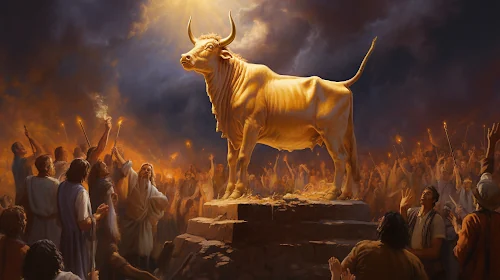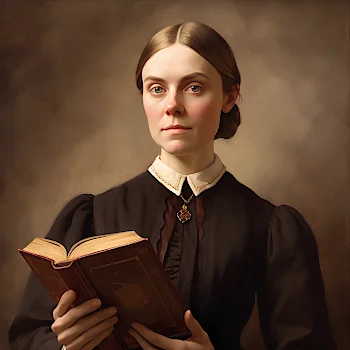A Biblical Philosophy of Art

Art can be used as a powerful tool for communicating human emotion, for teaching, and for worship. There are many forms of artistic expression, from literature, drama, and music, to visual arts such as photography, painting, sculpting, etc. All types of art have been used since the dawn of human history for many purposes, from day-to-day communication, to education, for enjoyment, or for worship.
In the Bible, music is used to praise God, but also to praise false gods. Beautiful sculptures and tapestries were made for the tabernacle service, but sculptures also served as idols that turned worship away from God. During the wilderness wanderings, God commanded Moses to form a serpent and place it on a pole to provide a means of healing from the deadly snake bites. God used this to teach a powerful lesson, but later Hezekiah had to destroy the serpent Moses had made, because it had become an idol-Nehushtan. (2 Kings 18:4) Jesus consistently used real visual imagery to portray the truths of God’s kingdom through parables. And the prophets received visions in which they saw, through visual symbols, the messages God wanted to communicate with His people.
The second commandment says “You shall not make for yourself a carved image–any likeness of anything that is in heaven above, or that is in the earth beneath, or that is in the water under the earth; you shall not bow down to them nor serve them….” (Exodus 20:4-5a, NKJV) Christians have long understood this command, not as a categorical prohibition on artistic representations, but as a clear prohibition on using these representations as objects or mediums of worship. This understanding is consistent with the Biblical examples: the golden cherubim in the wilderness tabernacle, the cherubim, palm trees, and flowers in Solomon’s temple, and the bronze serpent are all examples of visual arts prescribed by God for the true sanctuary worship. It’s worth noting, however, that these were, in a sense, auxiliary and not central to the focus of worship. The focus of true worship was always on the worship of the invisible and transcendent God, not on any object or representation. Whenever a representation was used (such as a golden calf), the Bible is clear that the worshipers had fallen into apostasy.
In my personal perspective, I believe that visual art is a powerful tool for teaching and communicating the gospel message. It can help us sense the reality of the ancient Biblical stories, and of the prophecies of the future glory of eternity. It can communicate messages of Christ’s love to our heart in ways that words cannot. (The same is true of music, although a thorough discussion of that subject would require a separate post). Hence I believe that visual arts can and should be used to teach the Bible, but that teachers and pastors should be careful to follow the principles that the Bible outlines. Here are a few that I recommend follow:
- Because I believe the Bible stories are true and accurate, I prefer artistic styles that communicate the Bible message in realistic ways. I want others to grasp the fact that Scripture is true and the stories actually took place. (I realize there is still room for teaching true stories using art mediums that people can and will connect with, so I’m not ruling out the possibility of teaching truth through anime, cartoon styles, etc–but I think we should be careful and clear about our purpose and to realize the potential that these mediums have to communicate untruths.)
- One purpose of Jesus’ incarnation was to demonstrate the character of God in human flesh. Hence I believe it is Biblical to visually portray the incarnate Christ, not so that we can worship him through the art, but so that we can better understand and communicate God’s character of love. Images of Jesus teaching and healing, His death and resurrection, His heavenly ministry, His second coming, all portray God’s character and the reality of our belief in ways that words cannot. Even images that imagine Jesus engaging in our modern-day world can be a powerful tool to communicate God’s love.
- I believe that we should not try to visually portray the invisible God, because this violates the second commandment. We should not use images of God or Jesus in places or ways that would invite worship of the image. For instance, I believe we should be careful about how we decorate the inside of our churches, in particular the front of the house of worship. When we bow to pray in corporate worship, although it can be powerful and moving, I don’t want to bow towards a painting of Jesus as though we are praying to the image.
- I believe that art, like everything else, should not be an end in itself. Art was given as a gift through which we glorify God and communicate His goodness to others. While it is not wrong to find pleasure in art, we should not create art for pleasure alone. This would include, of course, any sort of sensual gratification or excitement.
- I believe that art should never be used to cause harm to others. This would include (a) objectifying other people, such as how pornography objectifies women, (b) stereotyping people, particularly in a derogatory manner, (c) misrepresenting people, situations, or facts (bearing false witness), (d) speaking evil of others even if it is true, or (e) to manipulate or control another person or people.
There are likely other principles that could be added to this list. There is much excellent research on this subject, particularly this paper “Teaching Art History from a Biblical Foundation: Art History as a View into the Great Controversy” by Giselle Hasel.
A question I have asked myself recently is this: How can Artificial Intelligence be used to create art, when art is so integrally connected with worship and with human experience? While I cannot fully answer that question, I believe that AI is simply another tool in the hand of an artist that we can use to experience and express the feelings of our hearts. Computers, even AI, cannot truly think and feel–they are simply visualizing and expressing human emotions based on a vast store of human training data. Recently, I have been working on a “Virtual Bible Snapshot Project” to use AI to illustrate the Bible, chapter by chapter and topic by topic. While it’s still an imperfect tool, I believe this medium can be extremely valuable in creating art to teach the Bible.
My friend Shawn Hoffman of the Virtual Reality Bible Museum recently shared this collection of quotations with me, from Ellen G. White, one of the founders and pioneers of the Seventh-day Adventist Church. As a prolific author in the 1800’s, often her team of editorial staff had to source artwork to illustrate the books she was publishing. Here are some of her candid criticisms of some illustrations that were being incorporated into her books, and principles that she taught on this subject. Notes supplied are by Shawn Hoffman:
COUNSELS ON PICTURES AND ILLUSTRATIONS
This is intended to be a very brief overview of the principles Ellen White gives regarding illustrations and pictures. To understand the counsels in full it is best to read more extensively on the subject in her writings, but hopefully this overview will help people get started.
“Much money should not be invested in this line.”
“There have been long delays in the publication of our works waiting for illustrations,—delays that could be ill-afforded, and which have kept from the people the truths which they should have had….”
“When there are lessons in the pictures which lead to a study of the book itself, it is well; but when the pictures draw the attention from the truth contained in the book to themselves, the effort to help the book by illustrations is a failure.”
“Pictures to represent Bible scenes must be no cheap designs.”
“A proper illustration of Bible scenes requires talent of a superior quality.”
“God forbid that we should please the devil by lowering the standard of eternal truth by using illustrations that men, women, and children will make sport of.”
Counsels to Writers and Editors, chapter 24 – “Illustrating Our Literature”
“The ideas of many in reference to the matters pertaining to God’s work are too cheap. In the selection of pictures to illustrate holy things, a deficiency of wisdom has been shown that God cannot approve.”
Letter 39, 1899. Counsels to Writers and Editor
“The dummy of Thoughts From the Mount of Blessing, with the illustrations, I received. The illustrations I could not possibly accept under any consideration. Some of them look as if prepared for a comic almanac….
Pictures to represent Bible scenes must be no cheap designs…. The knowledge which God imparts is not of a character to belittle our ideas of sacred things. The glory of God must be kept before the mind’s eye, not the cheap, earthly representations that imprint in the memory scenes which give a false conception of Christ and heavenly things. A proper illustration of Bible scenes requires talent of a superior quality. With these cheap, common productions, the sacred lessons of the Bible disdain comparison….”
The Publishing Ministry, p. 217
Some example of poor illustrations:
“The cut in Gospel Reader, Moses viewing the Promised Land, does great injustice to the subject and great discredit to those who accepted it for the book. What sort of an impression will it make on the readers of the book? It is not in any sense a correct representation of Moses. It looks more like a picture of the great deceiver, Satan, after he had lost Paradise. { PM 216.3}
Letter 28a, 1897, in The Publishing Ministry, p. 216
Page 52, same book, “The Ark Standing in the Midst of Jordan“: see the cherubim on either end of the ark. What a misrepresentation of the heavenly angels looking with reverence upon the mercy seat, the cover of the ark. A child might take the representation as a bird hunched up. But when the ark was removed from the sanctuary, the cherubim were never exposed to view. That sacred ark, which represented Jehovah amid His people, was always covered, that no curious eye might look upon it. Let it ever be covered.
Letter 145, 1899, in Counsels to Writers and Editors, p. 171
“Would not the mind have clearer, more perfect ideas of angels, of Christ, of all spiritual things, if no pictures were made to represent heavenly things? Many of the pictures made are grossly false as far as truth is concerned. Do not pictures so far removed from the truth give voice to falsehoods? We want to be true in all our representations of Jesus Christ. But many of the miserable daubs put into our books and papers are an imposition on the public.”
“Neither God nor heaven nor Christ, who is the image of the Father, can be truly represented by the art of man. If the Lord had thought it advisable to represent Christ in this way, His person would have been described in the writings of the apostle. …We need not any external representations of the person of Christ. The imagination must take in the only begotten of the Father, “full of grace and truth,” the One altogether lovely and the chiefest among ten thousand.—. { PM 220.2} ” { PM 219.5}
Manuscript 131, 1899, in The Publishing Ministry, p. 219-220
(Note: There are two different ways these quotes could be interpreted – either no pictures should be made at all of Jesus or angels, or that they should only be of the most superior quality. Many of her books contained pictures of Jesus during his time on earth and also of angels. Of course she didn’t always approve of the artwork added to her books, but if she really meant that no pictures of Jesus, angels, or heaven should ever be used, it would seem like the publishers would have stopped using it in later books. The “Way of Life” illustrations commissioned by James and Ellen White also included a picture of Jesus on the cross, angels, and heaven in the background. So I’m not sure whether these quotes are meant to say we should never use art of Jesus, angels, or heaven, or just that they should be of the most superior quality.)
Keep out of the books illustrations of auto-da-fe, Catholic pictures of persecution and burning. It is enough to read of these wicked deeds, without trying to bring them in all their terrible details before the eyes.
And some of the cuts used are very inferior, and poorly illustrate the subjects represented. I hope our publications will not come to resemble a comic almanac. I would not altogether condemn the use of pictures, but let fewer be used, and only such as are good illustrations of the subject … If you choose to have a few pictures and good ones, I do not object. Let illustrations be choice rather than numerous.
Letter 28a, 1897, in Counsels to Writers and Editors, p. 172
(For examples of the comic almanacs that she was referring to, do a google image search for “inside pages of comic almanac 1800’s”
Books for certain people should be abundantly illustrated:
Life Sketches of Ellen G. White, 381, 382. (See Life Sketches of Ellen G. White, 213, 214.)
Many lines of business will open up as the work is carried forward. There is much work to be done in the South, and in order to do this work the laborers must have suitable literature, books telling the truth in simple language, and abundantly illustrated. This kind of literature will be the most effective means of keeping the truth before the people. A sermon may be preached and soon forgotten, but a book remains.


Leave a Reply